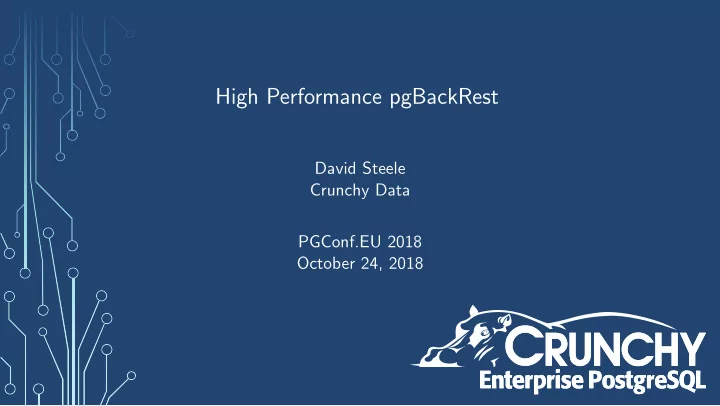

High Performance pgBackRest David Steele Crunchy Data PGConf.EU 2018 October 24, 2018
Agenda 1 Introduction 2 Core Commands 3 Archive Push 4 Backup Archive Get 5 Restore 6 Other Considerations 7 8 Questions? 2 / 16
About the Speaker Principal Architect at Crunchy Data, the Trusted Open Source Enterprise PostgreSQL Leader. Actively developing with PostgreSQL since 1999. PostgreSQL Contributor. Primary author of pgBackRest and co-author of pgAudit. 3 / 16
What is pgBackRest? pgBackRest aims to be a simple, reliable backup and restore system that can seamlessly scale up to the largest databases and workloads. pgBackRest has a strong emphasis on performance, including: Parallel/asynchronous operation for all core commands Backup from Standby Advanced configuration for tuning specific commands 4 / 16
Core Commands Archive Push Allows PostgreSQL to push a completed WAL segment to the repository. Backup Backup a PostgreSQL cluster. Archive Get Allows PostgreSQL to get a completed WAL segment from the repository. Restore Restore a PostgreSQL cluster. 5 / 16
Archive Push Features Asynchronous operation Asynchronously scan the archive status directory for WAL segments that are ready to be archived. Store status of each WAL segment locally so PostgreSQL can be notified via the archive command of success or failure. Asynchronous notification is written in pure C for performance. Parallelism Checksum, compress, encrypt, and transfer in parallel to improve throughput. 6 / 16
Archive Push Configuration pgbackrest.conf [global:archive-push] archive-async=y process-max=4 spool-path=/path/to/spool The spool-path parameter is optional (defaults to /var/spool/pgbackrest ). The spool directory must exist for asynchronous operation. 7 / 16
Backup Features Backup from Standby Perform most of the backup from a standby to reduce load on the primary. Primary and standby are automatically selected from a list of clusters. Parallelism Checksum, compress, encrypt, and transfer in parallel to improve throughput. 8 / 16
Backup Configuration pgbackrest.conf [global:backup] backup-standby=y process-max=8 [demo] pg1-host=pg1 pg1-path=/var/lib/postgresql/10 pg2-host=pg2 pg2-path=/var/lib/postgresql/10 pg3-host=pg3 pg3-path=/var/lib/postgresql/10 The current primary can be in any position in the list of PostgreSQL servers. The first live standby found will be used to perform the backup. 9 / 16
Archive Get Features Asynchronous operation Asynchronously build a queue of WAL segments that PostgreSQL will need. Move or copy segments from the queue when requested by restore command . The spool directory should be located on the same device as pg xlog / pg wal for best performance. Asynchronous notification is written in pure C for performance. Parallelism Transfer, decrypt, decompress, and checksum in parallel to improve throughput. 10 / 16
Archive Get Configuration pgbackrest.conf [global:archive-get] archive-async=y archive-get-queue-max=1GB process-max=2 Archive Get generally requires fewer processes than Archive Push because decompression is less CPU-intensive than compression. On the other hand, clusters in recovery generally have more CPU resources to spare. The idea is to keep PostgreSQL supplied with WAL so that it doesn’t need to wait. 11 / 16
Restore Features Delta operation Checksum local cluster files to determine what can be preserved. Transfer only files that have changed since the last backup from the repository. Parallelism Transfer, decrypt, decompress, and checksum in parallel to improve throughput. 12 / 16
Restore Configuration pgbackrest.conf [global:restore] process-max=16 The --delta option can be specified on the command-line to enable delta restore. 13 / 16
High Latency The process-max option can be used to speed transfers on high latency storage such as S3. 14 / 16
Compression The compress-level option can be lowered (e.g. 6 to 3 ) to reduce the CPU cost of compression. This also reduces the compression ratio, but the time savings are often worth it. 15 / 16
Questions? website: http://www.pgbackrest.org email: david@pgbackrest.org email: david@crunchydata.com releases: https://github.com/pgbackrest/pgbackrest/releases slides & demo: https://github.com/dwsteele/conference/releases 16 / 16
Recommend
More recommend